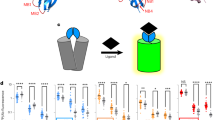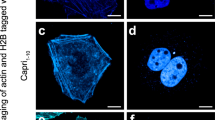Abstract
Membrane-permeant biarsenical dyes such as FlAsH and ReAsH fluoresce upon binding to genetically encoded tetracysteine motifs expressed in living cells1,2, yet spontaneous nonspecific background staining can prevent detection of weakly expressed or dilute proteins2,3. If the affinity of the tetracysteine peptide could be increased, more stringent dithiol washes should increase the contrast between specific and nonspecific staining. Residues surrounding the tetracysteine motif were randomized and fused to GFP, retrovirally transduced into mammalian cells and iteratively sorted by fluorescence-activated cell sorting for high FRET from GFP to ReAsH in the presence of increasing concentrations of dithiol competitors. The selected sequences show higher fluorescence quantum yields and markedly improved dithiol resistance, culminating in a >20-fold increase in contrast. The selected tetracysteine sequences, HRWCCPGCCKTF and FLNCCPGCCMEP, maintain their enhanced properties as fusions to either terminus of GFP or directly to β-actin. These improved biarsenical-tetracysteine motifs should enable detection of a much broader spectrum of cellular proteins.
This is a preview of subscription content, access via your institution
Access options
Subscribe to this journal
Receive 12 print issues and online access
$209.00 per year
only $17.42 per issue
Buy this article
- Purchase on Springer Link
- Instant access to full article PDF
Prices may be subject to local taxes which are calculated during checkout




Similar content being viewed by others
References
Griffin, B.A., Adams, S.R. & Tsien, R.Y. Specific covalent labeling of recombinant protein molecules inside live cells. Science 281, 269–272 (1998).
Adams, S.R. et al. New biarsenical ligands and tetracysteine motifs for protein labeling in vitro and in vivo: synthesis and biological applications. J. Am. Chem. Soc. 124, 6063–6076 (2002).
Stroffekova, K., Proenza, C. & Beam, K.G. The protein-labeling reagent FLASH-EDT2 binds not only to CCXXCC motifs but also non-specifically to endogenous cysteine-rich proteins. Pflugers Archiv. Eur. J. Physiol. 442, 859–866 (2001).
Gaietta, G. et al. Multicolor and electron microscopic imaging of connexin trafficking. Science 296, 503–507 (2002).
Ju, W. et al. Activity-dependent regulation of dendritic synthesis and trafficking of AMPA receptors. Nat. Neurosci. 7, 244–253 (2004).
Marek, K.W. & Davis, G.W. Transgenically encoded protein photoinactivation (FIAsH-FALI): Acute inactivation of synaptotagmin I. Neuron 36, 805–813 (2002).
Tour, O., Meijer, R.M., Zacharias, D.A., Adams, S.R. & Tsien, R.Y. Genetically targeted chromophore-assisted light inactivation. Nat. Biotechnol. 21, 1505–1508 (2003).
Andresen, M., Schmitz-Salue, R. & Jakobs, S. Short tetracysteine tags to β-tubulin demonstrate the significance of small labels for live cell imaging. Mol. Biol. Cell 15, 5616–5622 (2004).
Hoffmann, C. et al. A FlAsH-based FRET approach to determine G-protein coupled receptor activation in living cells. Nat. Methods 2, 171–176 (2005).
Panchal, R.G. et al. In vivo oligomerization and raft localization of Ebola virus protein VP40 during vesicular budding. Proc. Natl. Acad. Sci. USA 100, 15936–15941 (2003).
Rice, M.C., Bruner, M., Czymmek, K. & Kmiec, E.B. In vitro and in vivo nucleotide exchange directed by chimeric RNA/DNA oligonucleotides in Saccharomyces cerevisae . Mol. Microbiol. 40, 857–868 (2001).
Rice, M.C., Czymmek, K. & Kmiec, E.B. The potential of nucleic acid repair in functional genomics. Nat. Biotechnol. 19, 321–326 (2001).
Tsien, R.Y. The green fluorescent protein. Annu. Rev. Biochem. 67, 509–544 (1998).
Chen, I. & Ting, A.Y. Site-specific labeling of proteins with small molecules in live cells. Curr. Opin. Biotechnol. 16, 35–40 (2005).
Griffin, B.A., Adams, S.R., Jones, J. & Tsien, R.Y. Fluorescent labeling of recombinant proteins in living cells with FlAsH. Methods Enzymol. 327, 565–578 (2000).
Benhar, I. Biotechnological applications of phage and cell display. Biotechnol. Adv. 19, 1–33 (2001).
Rizzo, M.A., Springer, G.H., Granada, B. & Piston, D.W. An improved cyan fluorescent protein variant useful for FRET. Nat. Biotechnol. 22, 445–449 (2004).
Webb, Y., Hermida-Matsumoto, L. & Resh, M.D. Inhibition of protein palmitoylation, raft localization, and T cell signaling by 2-bromopalmitate and polyunsaturated fatty acids. J. Biol. Chem. 275, 261–270 (2000).
Cormack, B.P., Valdivia, R.H. & Falkow, S. FACS-optimized mutants of the green fluorescent protein (GFP). Gene 173, 33–38 (1996).
Daugherty, P.S., Iverson, B.L. & Georgiou, G. Flow cytometric screening of cell-based libraries. J. Immunol. Methods 243, 211–227 (2000).
Nguyen, A.W. & Daugherty, P.S. Evolutionary optimization of fluorescent proteins for intracellular FRET. Nat. Biotechnol. 23, 355–360 (2005).
Zufferey, R., Donello, J.E., Trono, D. & Hope, T.J. Woodchuck hepatitis virus posttranscriptional regulatory element enhances expression of transgenes delivered by retroviral vectors. J. Virol. 73, 2886–2892 (1999).
Cubitt, A.B., Woollenweber, L.A. & Heim, R. Understanding structure-function relationships in the Aequorea victoria green fluorescent protein. Methods Cell Biol. 58, 19–30 (1999).
Acknowledgements
We thank the VA Research Flow Cytometry Core Facility at UCSD and W. Coyt Jackson for flow cytometry assistance, Larry Gross for mass spectrometry support, Paul Steinbach and Qing Xiong for laboratory assistance, Thomas Hope (University of Illinois at Chicago) for the Bluescript SK+ WPRE plasmid, and members of the Tsien laboratory and FlAsHers group for helpful discussions. Some of the work included here was conducted at the National Center for Microscopy and Imaging Research, which is supported by US National Institutes of Health grant RR04050 (to Mark H. Ellisman, University of California, San Diego). This work was supported by NIH NS27177, GM 72033, Department of Energy DE-FG03-01ER63276 and the Howard Hughes Medical Institute.
Author information
Authors and Affiliations
Corresponding author
Ethics declarations
Competing interests
R.Y.T. is coinventor on certain patents assigned to the University of California, the value of which could be affected by this publication.
Supplementary information
Supplementary Fig. 1
Analysis of unique sequences isolated in Sort 14. (PDF 116 kb)
Supplementary Fig. 2
Inhibition of tetracysteine-specific membrane localization. (PDF 121 kb)
Supplementary Fig. 3
Dithiol resistance of alanine mutants point to key residues. (PDF 76 kb)
Supplementary Table 1
Quantum yields of FlAsH and ReAsH bound to optimized tetracysteine sequences fused to fluorescent proteins. (PDF 6 kb)
Supplementary Table 2
Oligonucleotide primer sequences. (PDF 30 kb)
Rights and permissions
About this article
Cite this article
Martin, B., Giepmans, B., Adams, S. et al. Mammalian cell–based optimization of the biarsenical-binding tetracysteine motif for improved fluorescence and affinity. Nat Biotechnol 23, 1308–1314 (2005). https://doi.org/10.1038/nbt1136
Received:
Accepted:
Published:
Issue Date:
DOI: https://doi.org/10.1038/nbt1136
This article is cited by
-
A straightforward approach for bioorthogonal labeling of proteins and organelles in live mammalian cells, using a short peptide tag
BMC Biology (2020)
-
Fluorescent amino acids as versatile building blocks for chemical biology
Nature Reviews Chemistry (2020)
-
Frequent pauses in Escherichia coli flagella elongation revealed by single cell real-time fluorescence imaging
Nature Communications (2018)
-
Application of molecular dynamics simulations to design a dual-purpose oligopeptide linker sequence for fusion proteins
Journal of Molecular Modeling (2018)
-
Protein recognition by a pattern-generating fluorescent molecular probe
Nature Nanotechnology (2017)



